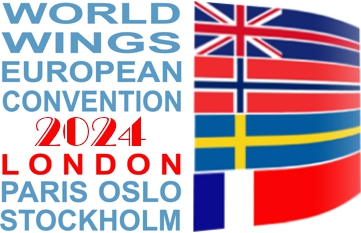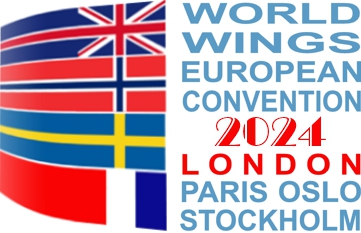

World Wings 2024 Convention
London
TRAVEL TIPS
From a tablet or computer, find your Settings, then choose Connections. From the list of available networks, select the network you want to connect to, then provide a password, if required. Be very cautious about using any network that displays as “unsecured.”
A mobile phone can connect via a wi-fi network, just like a computer, or it can connect via a cell tower. Using a cellular connection relies on a SIM card to access nearby cell towers, and can be very expensive if you are connecting to a different provider than the one to which you normally subscribe (this is called roaming).
If your phone is “locked” to a specific provider (ATT, Verizon, T-Mobile, etc), you may want to consider purchasing a plan from your mobile provider that allows you to use your phone in Europe. These plans typically offer a certain number of minutes for calls and a defined amount of data usage. Look in your phone’s settings for “Network Operators.” If you do not see other options aside from your carrier, then your phone is locked.
If your phone is “unlocked”, another option is to purchase a SIM card when you get to London. There are vendors in the airport who can assist you, as you must remove your existing SIM card and replace it with one from a local carrier. This also changes your phone number until you put your original card back in. Don’t lose your original SIM card!
If you choose not to purchase a plan from your mobile provider and are not purchasing a SIM card to use in the UK, take these three steps when leaving the US:
- 1) turn off Roaming on your phone,
- 2) put your phone in Airplane Mode,
- 3) turn off your phone.
Do not turn your phone on until you have returned to the US. Failure to take these steps can result in an exorbitant bill for your mobile phone. It’s important to take all three steps, as the first two will help protect you in case your phone is turned on inadvertently, in which case it would start using data for any apps that might be running on the phone, like your Apple or Fitbit watch, or a weather app, or email. Roaming charges add up quickly and could end up costing you a fortune.
Voltage
The US uses 110-120 voltage, whereas the UK and Europe use 220-240. Most modern electronic devices (such as mobile phones, tablets, laptops, and even your electric toothbrush) are dual voltage, and will automatically manage both. On your device look at the markings, or refer to the device’s documentation to verify. If you see something like “INPUT AC 120/240 V 50—60 Hz 1300 W,” then you can safely use it for voltages between 120 V and 240 V. If this is the case, you’ll only need a plug adapter. Some appliances, like hair dryers and flat/curling irons, have a selector that allows you to choose the appropriate voltage. The hotel provides hair dryers, so it may not be necessary to bring your own. Regardless, do check your device/appliance before plugging it in. For any device that is 110-120V only, leave it at home or or bring a voltage converter.
Plug Adapters
The UK and Ireland use a Type G plug. This is a three-prong plug and all the prongs are flat.
If you are extending your travel to other countries in Europe, pick up a Type C/D plug (most of Europe) and a Type E/F plug (mostly France). These have round prongs. with E/F having slightly fatter prongs than C/D.
All three adapter types (G, C/D, and E/F) are available on Amazon. Some also have USB ports for charging your electronic devices.
Travel Voltage Converters
If you have a device that takes only 110-120V and you cannot live without it, you will also need a converter. A converter steps voltage down between a 220 electrical outlet and your 120 device. There are small, cube-shaped converters that can be used for single devices that do not consume a lot of power (think cell phone or toothbrush). Conveniently, some of these come equipped with USB charging ports. Devices that draw more power (think hair dryer, curling iron, or travel iron), however, require larger and more powerful converters.
For details and current fares, follow this link: https://tfl.gov.uk/fares/how-to-pay-and-where-to-buy-tickets-and-oyster/pay-as-you-go/contactless-and-mobile-pay-as-you-go
For details about the Thames Clipper boats, follow this link: https://www.thamesclippers.com/plan-your-journey/ticket-information
